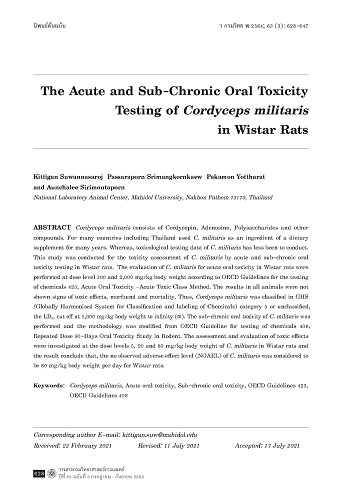การทดสอบความเป็นพิษเฉียบพลันและพิษกึ่งเรื้อรังทางปากของถั่งเช่าสีทอง (Cordyceps militaris) ในหนูแรทสายพันธุ์ Wistar
คำสำคัญ:
ถั่งเช่าสีทอง, การทดสอบความเป็นพิษเฉียบพลัน, การทดสอบความเป็นพิษกึ่งเรื้อรัง, OECD Guidelines หมายเลข 423, OECD Guidelines หมายเลข 408บทคัดย่อ
Cordyceps militaris ประกอบด้วย Cordycepin, Adenosine, Polysaccharides และสารประกอบอื่นๆ สำหรับหลายประเทศรวมทั้งประเทศไทยนำ C. militaris มาใช้เป็นส่วนผสมของผลิตภัณฑ์เสริมอาหารในช่วงหลายปีที่ผ่านมา ในขณะที่ยังไม่มีข้อมูลการทดสอบทางพิษวิทยาของ C. militaris อย่างเพียงพอ การศึกษาในครั้งนี้จัดทำขึ้นเพื่อประเมินความเป็นพิษของ C. militaris โดยการทดสอบความเป็นพิษทางปากแบบเฉียบพลันและแบบกึ่งเรื้อรังในหนูแรทสายพันธุ์ Wistar สำหรับการประเมินความเป็นพิษเฉียบพลันที่ขนาด 300 และ 2,000 มิลลิกรัมต่อกิโลกรัมของนํ้าหนักตัวสัตว์ทดลองตามวิธีการมาตรฐาน OECD Guideline หมายเลข 423 ผลการทดสอบในสัตว์ทดลองทุกตัวพบว่า ไม่ก่อให้เกิดความเป็นพิษและการตายในสัตว์ทดลอง ดังนั้น C. militaris จัดอยู่ในระบบการจัดกลุ่มสารเคมี การติดฉลาก และการแสดงรายละเอียดบนเอกสารข้อมูลความปลอดภัยสากลหมวดที่ 5 หรือไม่ระบุประเภท มี LD50 ที่ 5,000 มิลลิกรัมต่อกิโลกรัมของนํ้าหนักตัวสัตว์ทดลองขึ้นไป หลังจากนั้นได้ทำการทดสอบความเป็นพิษของ C. militaris ทางปากแบบกึ่งเรื้อรังและวิธีการทดสอบได้มีการประยุกต์จากวิธีการมาตรฐาน OECD Guideline หมายเลข 408 การประเมินความเป็นพิษทำการศึกษาที่ขนาด 5, 20 และ 80 มิลลิกรัมต่อกิโลกรัมของนํ้าหนักตัวสัตว์ทดลอง ผลการทดสอบสรุปได้ว่า ปริมาณที่มากที่สุดที่ได้รับต่อเนื่องเป็นเวลานานโดยไม่ก่อให้เกิดอันตรายใดๆ ต่อร่างกายต่อวันในสัตว์ทดลอง คือ 80 มิลลิกรัมต่อกิโลกรัมของนํ้าหนักตัวสัตว์ทดลอง
เอกสารอ้างอิง
Buenz EJ, Bauer BA, Osmundson TW, Motley TJ. The traditional Chinese medicine Cordyceps sinensis and its eff ects on apoptotic homeostasis. J Ethnopharmacol 2005; 96(1-2): 19-29.
Wen TC, Lei BX, Kang JC, Li GR, He J. Enhanced production of mycelial culture using additives and cordycepin by submerged in Cordyceps militaris. Food Ferment Ind 2009; 35(8): 49-53.
Li HC, Sun P, Feng CQ. The research of cordycepin as an active component in Cordyceps. J Jinggangshan Univ (Nat Sci) 2010; 31(2): 93-6.
Jhou BY, Fang WC, Chen YL, Chen CC. A 90 - day subchronic toxicity study of submerged mycelial culture of Cordyceps militaris in rats. Toxicol Res 2018; 7(5): 977-86.
Park C, Hong SH, Lee JY, Kim GY, Choi BT, Lee YT, et al. Growth inhibition of U937 leukemia cells by aqueous extract of Cordyceps militaris through induction of apoptosis. Oncol Rep 2005; 13(6): 1211-6.
Ng TB, Wang HX. Pharmacological actions of Cordyceps, a prized folk medicine. J Pharm Pharmacol 2005; 57(12): 1509-19.
Nan JX, Park EJ, Yang BK, Song CH, Ko G, Sohn DH. Antifibrotic effect of extracellular biopolymer from submerged mycelial cultures of Cordyceps militaris on liver fibrosis induced by bile duct ligation and scission in rats. Arch Pharm Res 2001; 24(4): 327-32.
Zhao-Long W, Xiao-Xia W, Wei-Ying C. Inhibitory effect of Cordyceps sinensis and Cordyceps militaris on human glomerular mesangial cell proliferation induced by native LDL. Cell Biochem Funct 2000; 18(2): 93-7.
Won SY, Park EH. Anti-inflammatory and related pharmacological activities of cultured mycelia and fruiting bodies of Cordyceps militaris. J Ethnopharmacol 2005; 96(3): 555-61.
Yoo HS, Shin JW, Cho JH, Son CG, Lee YW, Park SY, et al. Effects of Cordyceps militaris extract on angiogenesis and tumor growth. Acta Pharmacol Sin 2004; 25(5): 657-65.
Choi SB, Park CH, Choi MK, Jun DW, Park S. Improvement of insulin resistance and insulin secretion by water extracts of Cordyceps militaris, Phellinus linteus and Paecilomyces tenuipes in 90% pancreatectomized rats. Biosci Biotechnol Biochem 2004; 68(11): 2257-64.
Lin XX, Xie QM, Shen WH, Chen Y. Effects of fermented Cordyceps powder on pulmonary function in sensitized guinea pigs and airway inflammation in sensitized rats. China J Chin Mater Med 2001; 26(9): 622-5.
Panda AK, Swain KC. Traditional uses and medicinal potential of Cordyceps sinensis of Sikkim. J Ayurveda Integr Med 2011; 2(1): 9-13.
Kim YO, Kim HJ, Abu-Taweel GM, Oh J, Sung GH. Neuroprotective and therapeutic effect of Cordyceps militaris on ischemia-induced neuronal death and cognitive impairments. Saudi J Biol Sci 2019; 26(7): 1352-7.
Zhou X, Yao Y. Unexpected nephrotoxicity in male ablactated rats induced by Cordyceps militaris: the involvement of oxidative changes. Evid Based Complement Alternat Med 2013; 2013: 786528. (9 pages).
Zhu SJ, Pan J, Yang JJ, Zhou A. Immune activation and toxicity evaluation of fresh Cordyceps militaris extracts by high-pressure processing. Food Agr Immunol 2015; 26(5): 645-58.
Kwack SJ, Lee BM. Subacute oral toxicity study of a new type of Cordyceps, Paecilomyces sinclairii, in Sprague-Dawley rats. Toxicol Res 2009; 25(2): 101-6.
Organisation for Economic Cooperation and Development (OECD). Test no. 423: acute oral toxicity – acute toxic class method, OECD guidelines for the testing of chemicals. [online]. 2001; [cited 2021 Feb 16]; [14 screens]. Available from: URL: https://www.oecd-ilibrary.org/docserver/9789264071001-en.pdf?expires=1613451653&id=id&accname=guest&checksum=0023ABD857B31C6E4DF95A0FAA33E582.
Organisation for Economic Cooperation and Development (OECD). Test no. 408: repeated dose 90-days oral toxicity study in rodents, OECD guidelines for the testing of chemicals. [online]. 1998; [cited 2021 Feb 16]; [10 screens]. Available from: URL: https://www.oecd.org/env/ehs/testing/E408_1998.PDF
Institute for Laboratory Animal Research, Division on Earth and Life Studies, National Research Council. Guide for the care and use of laboratory animals. 8th ed. Washington, DC: The National Academies Press; 2011.
Office of Animal Care and Use. Guidelines for euthanasia of rodent fetuses and neonates. [online]. 2013; [cited 2019 Jun 18]; [3 screens]. Available from: URL: https://oacu.oir.nih.gov/system/files/media/file/2021-02/b4_rodent_euthanasia_pup.pdf.
Mooi E, Sarstedt M. Hypothesis testing & ANOVA. In: A concise guide to market research. 3rd ed. Berlin, Germany: Springer-Verlag GmbH; 2011. p. 113-160.
Ference BA, Ginsberg HN, Graham I, Ray KK, Packard CJ, Bruckert E, et al. Low - density lipoproteins cause atherosclerotic cardiovascular disease. 1. Evidence from genetic, epidemiologic, and clinical studies. A consensus statement from the European Atherosclerosis Society Consensus Panel. Eur Heart J 2017; 38(32): 2459-72.
Assmann G, Gotto AM. HDL cholesterol and protective factors in atherosclerosis. Circulation 2004; 109(23 Suppl 1): III8-14.
Fruchart JC, Nierman MC, Stroes ESG, Kastelein JJP, Duriez P. New risk factors for atherosclerosis and patient risk assessment. Circulation 2004; 109(23 Suppl 1): III15-9.
Hobbie K, Elmore SA, Kolenda-Roberts HM. NTP nonneoplastic lesion atlas: spleen - accessory spleen. [online]. [cited 2021 Jun 13]; [2 screens]. Available form: URL: https://ntp.niehs.nih.gov/nnl/immune/spleen/accessory/spleen-accessory-spleen-pdf_508.pdf.




